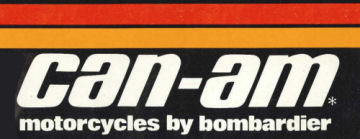| Stuff you might like to know about Bombardier Can-Am motorcycles: |
- TnT stands for "Track N Trail"
|
- ASE stands for "Air-cooled Single Shock
Enduro"
|
- Early MXer's (through the MX-3 model) used oil
injection instead of premixing. The backbone of the frame served as the reservoir, with a
fill hole and dipstick located just behind the steering head. The Mikuni oil pump was
locked in the "full on" position and regulated only by engine RPM.
|
- TNT's and Qualifier models also used oil injection
(through the Qualifier II). On these dual-sport and enduro bikes, the throttle cable split
into a "Y" at midpoint so that the oil pump was regulated by both RPM and
throttle position. They used the same backbone reservoir as the MX bikes. Although the
injection system offered longer engine life and proved itself to be reliable, there
appeared to be a great deal of public skepticism about 2-stroke race bikes with oil
injection systems. Later MX and Qualifier models dropped the system and went back to
pre-mixing.
|
- All Can-Am's up to 276.7cc used rotary valve
engines. The carburetor was located near the rear of the engine with a long intake
manifold carrying the air/fuel mixture to the left side of the motor where the rotary
valve regulated the flow. This is what allowed these high output engines to have such a
wide range of usable power. The rotary valve timing was different between MX and enduro
models (cut and positioned differently on the crankshaft).
|
 |
|
- The 370 and 400 engines used reed valves which were
fit into the case halves.
|
- Early models "breathed" air from a gap
between the rear of the seat and the top of the rear fender. Later models took in air from
the steering head area and tunneled it through the frame backbone to the airbox located
under the seat. With either design, these motorcycles could be ridden through extremely
deep water crossings without flooding out.
|
 |
|
- On MX1 - MX4 models, the steering head angle could
be adjusted by reversing or replacing the steering head bearing cups.
|
- MX6a models had S&W rear shocks as standard,
with remote reservoir Ohlins as an option for $150 extra. Ohlins became standard on the b
model.
|
- Most MX models came with lighting coils - just
in case.
|
- The rotary valve Qualifier III 350 was only 276.7cc.
Basically it was a 250 bottom end with a 76mm bore.
|
- CanAm's were originally made in Canada by Bombardier
(the Ski-Doo snowmobile company). Later models, 1983 - 1987 were made by Armstrong/CCM in
England.
|
- In 1978 CanAm changed the bore and stroke on the 250
from 74mm X 57.5mm to 72mm X 61mm in order to widen the powerband. This initally affected
only the MX-4 models but the later Qualifiers are also long strokes.
|
- It's rumored that Rotax has only had one reported
case of a failed Mikuni oil pump, and that was due to the fact that the owner was running
80W gear oil in the injection resivor instead of 2 cycle oil.
|
- MX-1 250's have so much power that it's hard to get
traction. Some riders have been known to detune the early 250's in order to get them
to "hook up."
|

